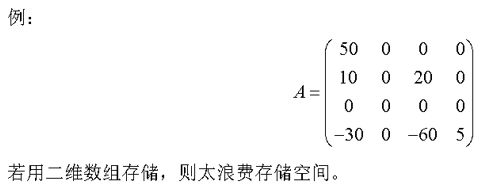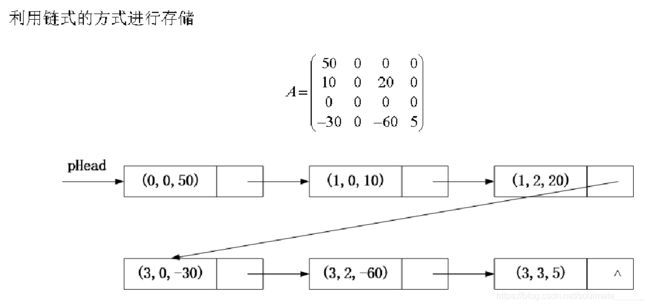数据结构:稀疏矩阵
稀疏矩阵
稀疏矩阵的定义与操作
稀疏矩阵的操作
using System;
using System.Collections.Generic;
using System.Linq;
using System.Text;
using System.Threading.Tasks;
namespace DataStruct2020.demo
{
public interface IMatrix<T>
{
int Cols { get; }
int Rows { get; }
T this[int i, int c] { get;set; }
IMatrix<T> Add(IMatrix<T> b);
IMatrix<T> Multiply(IMatrix<T> b);
IMatrix<T> Transpoese();
}
}
稀疏矩阵的存储与实现
using System;
using System.Collections.Generic;
using System.Linq;
using System.Text;
using System.Threading.Tasks;
namespace DataStruct2020.demo
{
public class Triple
{
private int _col;
private int _row;
private double _value;
public int Col
{
get { return _col; }
}
public int Row
{
get { return _row; }
}
public double Value
{
get { return _value; }
set { _value = value; }
}
public Triple(int i, int j, double value)
{
if (i < 0 || j < 0)
throw new ArgumentOutOfRangeException();
_row = i;
_col = j;
_value = value;
}
public int CompareTo(Triple other)
{
if (_value < other._value)
return -1;
if (_value > other._value)
return 1;
return 0;
}
public override string ToString()
{
return string.Format("{0},{1},{2}", _row, _col, _value);
}
}
}
using System;
using System.Collections.Generic;
using System.Linq;
using System.Text;
using System.Threading.Tasks;
namespace DataStruct2020.demo
{
public class SparseMatrix : IMatrix<double>
{
private SLinkList<Triple> _lst;
private int _rows;
private int _cols;
public int Rows
{
get { return _rows; }
}
public int Cols
{
get { return _cols; }
}
public SparseMatrix(int rows, int cols)
{
if (rows <= 0 || cols <= 0)
throw new ArgumentOutOfRangeException();
_rows = rows;
_cols = cols;
_lst = new SLinkList<Triple>();
}
private int GetIndex(int i, int j)
{
if (i < 0 || i > _rows - 1 || j < 0 || j > Cols - 1)
throw new ArgumentOutOfRangeException();
SNode<Triple> temp = _lst.PHead;
int result = 0;
while (temp != null)
{
if (temp.Data.Row == i && temp.Data.Col == j)
break;
temp = temp.Next;
result++;
}
return result == _lst.Length ? -1 : result;
}
public double this[int i, int j]
{
get
{
if (i < 0 || i > _rows - 1 || j < 0 || j > Cols - 1)
throw new ArgumentOutOfRangeException();
int index = GetIndex(i, j);
if (index == -1) return 0.0;
return _lst[index].Value;
}
set
{
if (i < 0 || i > _rows - 1 || j < 0 || j > Cols - 1)
throw new ArgumentOutOfRangeException();
int index = GetIndex(i, j);
if (index == -1)
{
if (value != 0.0)
_lst.InsertAtRear(new Triple(i, j, value));
}
else
{
if (value != 0.0)
_lst[index].Value = value;
else
_lst.Remove(index);
}
}
}
public SparseMatrix Add(SparseMatrix b)
{
if (b == null)
throw new ArgumentNullException();
if (_rows != b.Rows || _cols != b.Cols)
throw new Exception("两个矩阵不能进行加法");
SparseMatrix result = new SparseMatrix(_rows, _cols);
for (int i = 0; i < _rows; i++)
for (int j = 0; j < _cols; j++)
result[i, j] = this[i, j] + b[i, j];
return result;
}
public SparseMatrix Multiply(SparseMatrix b)
{
if (b == null)
throw new ArgumentNullException();
if (_cols != b.Rows)
throw new Exception("两个矩阵不能做乘法");
SparseMatrix result = new SparseMatrix(_rows, b._cols);
for (int i = 0; i < _rows; i++)
{
for (int j = 0; j < b._cols; j++)
{
result[i, j] = 0;
for (int k = 0; k < _cols; k++)
{
result[i, j] += this[i, k] * b[k, j];
}
}
}
return result;
}
public SparseMatrix Transpose()
{
SparseMatrix result = new SparseMatrix(_cols, _rows);
for (int i = 0; i < _cols; i++)
{
for (int j = 0; j < _rows; j++)
result[i, j] = this[j, i];
}
return result;
}
public static SparseMatrix operator +(SparseMatrix a, SparseMatrix b)
{
if (a == null || b == null)
throw new ArgumentNullException();
return a.Add(b);
}
public static SparseMatrix operator *(SparseMatrix a, SparseMatrix b)
{
if (a == null || b == null)
throw new ArgumentNullException();
return a.Multiply(b);
}
IMatrix<double> IMatrix<double>.Add(IMatrix<double> b)
{
if (b == null)
throw new ArgumentNullException();
return Add((SparseMatrix)b);
}
IMatrix<double> IMatrix<double>.Multiple(IMatrix<double> b)
{
if (b == null)
throw new ArgumentNullException();
return Multiply((SparseMatrix)b);
}
IMatrix<double> IMatrix<double>.Transpose()
{
return Transpose();
}
public override string ToString()
{
string result = string.Empty;
for (int i = 0; i < _lst.Length; i++)
{
result += _lst[i] + "\n";
}
return result;
}
}
}
//客户端
IMatrix<double> a = new SparseMatrix(2, 3);
IMatrix<double> b = new SparseMatrix(3, 2);
SparseMatrix c = new SparseMatrix(2, 2);
a[0, 2] = 1;
a[1, 0] = 1;
b[1, 1] = 4;
b[2, 0] = 1;
c[0, 1] = 1;
c[1, 0] = 1;
SparseMatrix d = (SparseMatrix)a * (SparseMatrix)b + c;
IMatrix<double> e = a.Multiple(b).Add(c);
Console.WriteLine("D:\n{0}", d);
Console.WriteLine("E:\n{0}", e);






